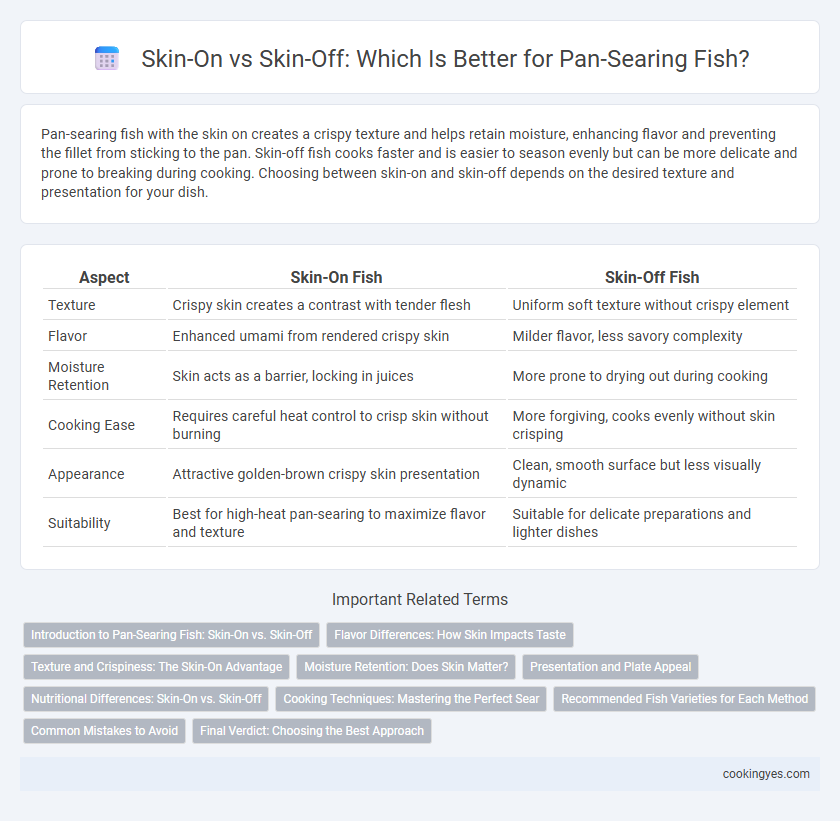Pan-searing fish with the skin on creates a crispy texture and helps retain moisture, enhancing flavor and preventing the fillet from sticking to the pan. Skin-off fish cooks faster and is easier to season evenly but can be more delicate and prone to breaking during cooking. Choosing between skin-on and skin-off depends on the desired texture and presentation for your dish.
Table of Comparison
| Aspect | Skin-On Fish | Skin-Off Fish |
|---|---|---|
| Texture | Crispy skin creates a contrast with tender flesh | Uniform soft texture without crispy element |
| Flavor | Enhanced umami from rendered crispy skin | Milder flavor, less savory complexity |
| Moisture Retention | Skin acts as a barrier, locking in juices | More prone to drying out during cooking |
| Cooking Ease | Requires careful heat control to crisp skin without burning | More forgiving, cooks evenly without skin crisping |
| Appearance | Attractive golden-brown crispy skin presentation | Clean, smooth surface but less visually dynamic |
| Suitability | Best for high-heat pan-searing to maximize flavor and texture | Suitable for delicate preparations and lighter dishes |
Introduction to Pan-Searing Fish: Skin-On vs. Skin-Off
Pan-searing fish with the skin on creates a crispy texture and helps retain moisture, enhancing flavor and presentation. Skin-off fillets cook faster and allow more even seasoning absorption but require careful handling to prevent sticking and breaking. Choosing between skin-on and skin-off depends on the desired texture and cooking technique for optimal results.
Flavor Differences: How Skin Impacts Taste
Pan-searing fish with the skin on enhances flavor by rendering the skin crispy, adding a savory, slightly salty crunch that contrasts with the tender flesh. The Maillard reaction occurring on the skin surface intensifies umami notes, providing a richer taste experience compared to skin-off fillets. Skin-off fish tends to lose these flavor complexities, often resulting in a milder, less textured dish.
Texture and Crispiness: The Skin-On Advantage
Pan-searing fish with the skin on enhances texture by creating a crispy, golden crust that contrasts with the tender flesh underneath. The skin acts as a barrier, retaining moisture and preventing the fish from drying out during cooking. This method results in a more flavorful and visually appealing dish compared to skin-off fillets, which tend to cook faster but lack the same crispiness and protection.
Moisture Retention: Does Skin Matter?
Skin-on fish fillets retain moisture more effectively during pan-searing due to the protective barrier the skin provides against direct heat, preventing excessive evaporation. The skin also helps to render natural fats, which baste the fish and enhance juiciness. Skin-off fillets tend to dry out faster, resulting in a less tender and flavorful final dish.
Presentation and Plate Appeal
Skin-on fish provides a visually striking presentation with its crispy, golden-brown texture that enhances plate appeal and contrasts beautifully with the tender flesh. Removing the skin often results in a cleaner, more delicate appearance, allowing vibrant garnishes and sauces to stand out for an elegant plating. Chefs prioritize skin-on for a rustic, textured look while opting for skin-off to emphasize refinement and colorful accompaniments.
Nutritional Differences: Skin-On vs. Skin-Off
Pan-searing fish with the skin on retains essential omega-3 fatty acids, vitamins A and D, and natural antioxidants concentrated in the skin, enhancing the nutritional value. Skin-off fish loses these benefits due to the removal of the protective fatty layer, which also helps retain moisture and nutrients during cooking. Retaining the skin maximizes the intake of heart-healthy fats and fat-soluble vitamins crucial for overall health.
Cooking Techniques: Mastering the Perfect Sear
For pan-searing, skin-on fish retains moisture and provides a crispy texture when cooked over medium-high heat, ensuring the skin acts as a natural barrier against direct heat. Skin-off fillets require precise temperature control and frequent oiling to prevent sticking and achieve a golden crust without drying out the flesh. Mastering these techniques enhances flavor and texture, making the choice between skin-on and skin-off pivotal for professional-quality seared fish.
Recommended Fish Varieties for Each Method
Skin-on fish is ideal for pan-searing varieties like salmon, sea bass, and trout due to its ability to provide a crispy texture and protect the delicate flesh from overcooking. Skin-off fish such as cod, halibut, and tilapia works well for pan-searing when a more uniform cook and easy seasoning absorption are desired. Selecting the appropriate fish type enhances flavor retention and ensures optimal cooking performance.
Common Mistakes to Avoid
Leaving the skin on during pan-searing helps retain moisture and develop a crispy texture, but a common mistake is not scoring the skin to prevent curling. Overcrowding the pan reduces heat distribution, causing uneven cooking and soggy skin. Removing the skin too early forfeits the flavor and texture benefits, leading to a dry and less flavorful fillet.
Final Verdict: Choosing the Best Approach
Skin-on fish fillets deliver superior texture and flavor retention during pan-searing by providing a crisp, protective barrier that locks in moisture and enhances browning. Skin-off fillets offer faster cooking and easier seasoning absorption, but risk drying out without the skin's moisture preservation qualities. For optimal results, prioritize skin-on for delicate fish like salmon or sea bass to achieve a golden crust and juicy interior, while skin-off works better for firmer fish that benefit from a more uniform sear.
Skin-on vs Skin-off for pan-searing Infographic

 cookingyes.com
cookingyes.com